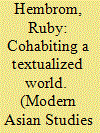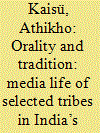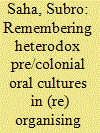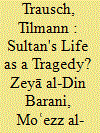| Srl | Item |
| 1 |
ID:
187283


|
|
|
|
|
| Summary/Abstract |
Stories matter—writing them down matters. For indigenous (Adivasi) peoples from oral traditions, literature has become a way to maintain culture and keep it alive. This article too is a story—an investigative one—questioning and vocalizing the challenges we encounter in trying to articulate our realities and histories in a form that is new to us, one that we've been denied as a practice and one we are not believed we are entitled to use. Mainstream cultures have side-lined, overshadowed, and subjugated our knowledge systems, placing us in structures we have to traverse, and within which we have to exist, which is possible only by internalizing and mirroring others' or mainstream ways and languages to gain legitimacy as peoples or, worse, being branded and judged by their versions of narratives of us. This article plots the course of Adivasi histories and narratives enduring, outlasting, or being demolished by dislocation and dispossession, by dominant languages and cultures, and how both writing and orality are practices of both resistance and resurgence.
|
|
|
|
|
|
|
|
|
|
|
|
|
|
|
|
| 2 |
ID:
180614


|
|
|
|
|
| Summary/Abstract |
Long before the onset of information revolution, human society has strong tradition of media life. Media is cultural deterministic and embedded in everyday lifeworld of human society. Mediated and saturated media world is not the only factor that makes media popular although media studies and communication as discipline is a modern phenomenon. Human beings have been using effectively to convey and communicate message through their everyday life experience and social practices since ages. Whatever human beings practice and do convey some meaning so it is the message. Oral culture is constantly reinforced in the form of retelling and renarrating of what we have heard and learnt from other mediums thereby making orality ubiquitous in some way or the other.
|
|
|
|
|
|
|
|
|
|
|
|
|
|
|
|
| 3 |
ID:
190732


|
|
|
|
|
| Summary/Abstract |
The paper explores what a (re)organisation of the existing histories of Bangla literature from Dalit literary perspectives can offer. Towards this end, it examines some of the early questions on the formation of literary standards and how that remained directly connected with caste hierarchies. It turns briefly towards late eighteenth and early nineteenth century Calcutta as a discursive-material site to explore symptomatically how such organising of dominant literary standards works its way through various forms of exclusion. When seen from the perspective of these exclusions, what does the question of Dalit literature offer in transforming the very idea of ‘literariness’? Also, what can the vernacular literatures offer in the reception of Dalit literatures in their multiplicity while resisting the tendencies of homogenising their volatility? Addressing such concerns, the paper turns towards a conceptualisation of Bangla Dalit literature as offering a poetics for multiple forms of dwelling.
|
|
|
|
|
|
|
|
|
|
|
|
|
|
|
|
| 4 |
ID:
186553


|
|
|
|
|
| Summary/Abstract |
This article examines how Zeyā al-Din Barani may have imagined that contemporary audiences would consume his Tārikh-e Firuz Shāhi. Would it only be read visually or also read aloud (directed at the ear rather than the eye), and thus be received aurally, or would it even be performed in front of a larger audience? The plot and protagonists of Barani's story on Moʿezz al-Din Keyqobād present a tragedy that develops around a sultan doomed to fail. An examination of the set-up of Barani's narrative reveals that it contains numerous textual devices that would enable a storyteller to perform the story, using the text as a kind of tumār. As tragedies are written for the stage, not the study, these features of the text indicate that matters of orality, which are crucial for many genres of premodern Persianate courtly literature, are also relevant to the Tārikh-e Firuz Shāhi.
|
|
|
|
|
|
|
|
|
|
|
|
|
|
|
|